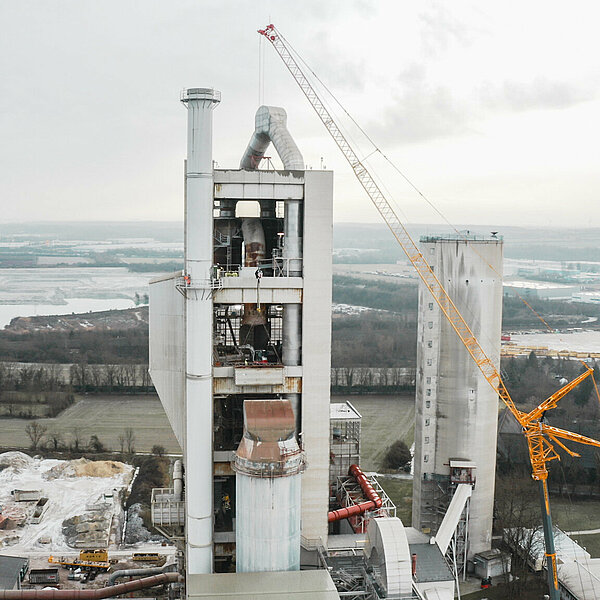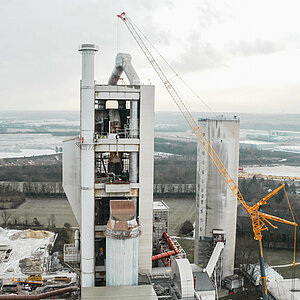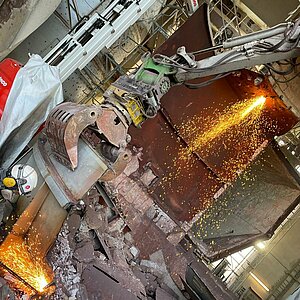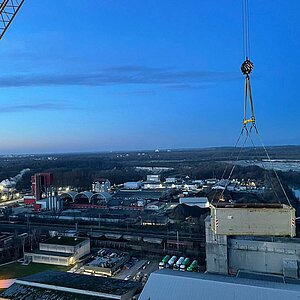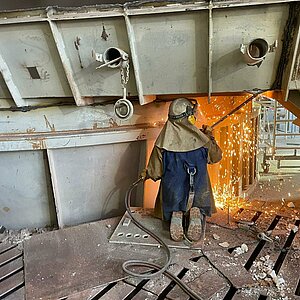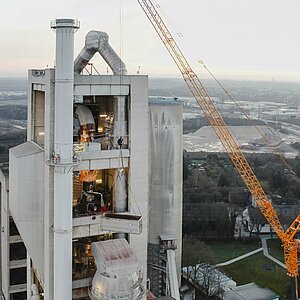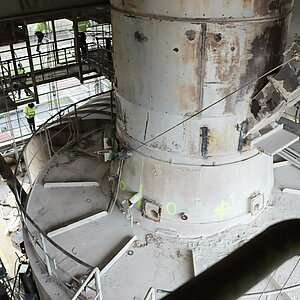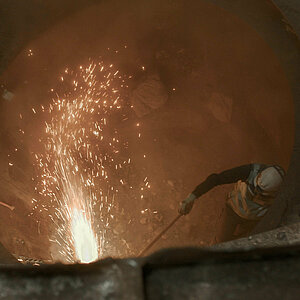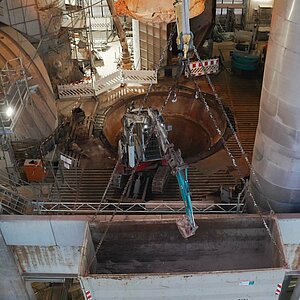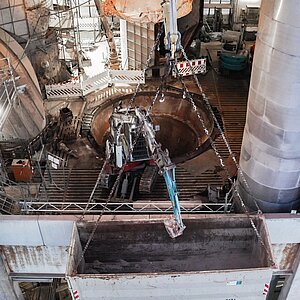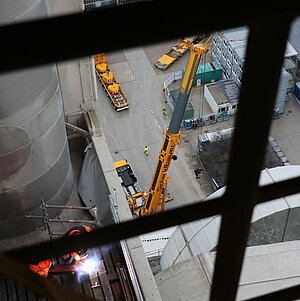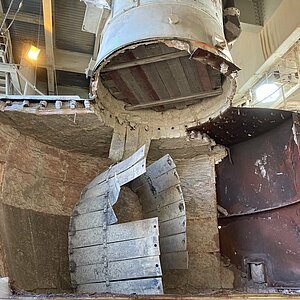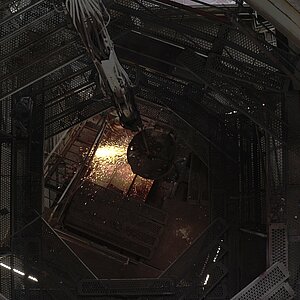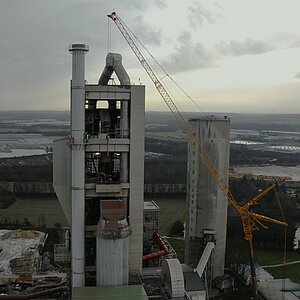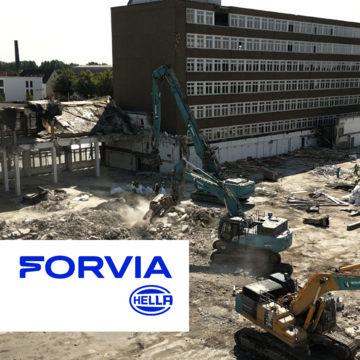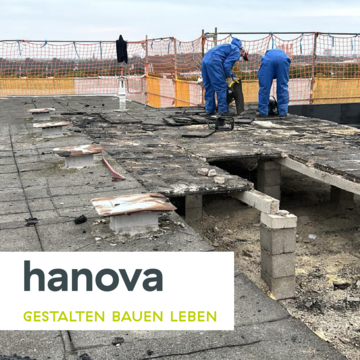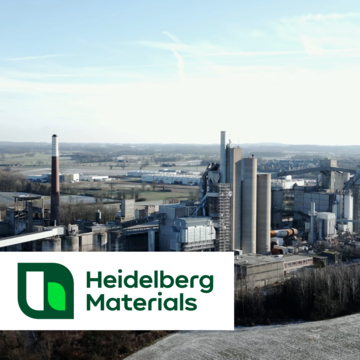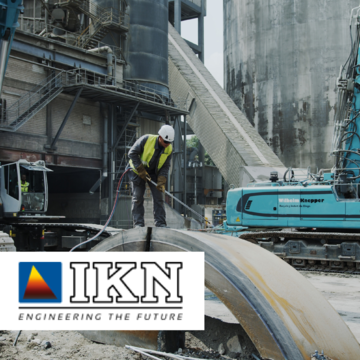Work carried out
- Dismantling of cyclone stage IV in a heat exchanger at a height of 65 m
- Complete conceptualization of the measure and creation of a detailed dismantling concept
- Complete dismantling and scrapping of the system in a 24-hour operation
Machines in use
- Tracked excavator up to 8 tons operating weight in the heat exchanger incl. craneable skips
- Lifting platforms for dismantling work in the heat exchanger
- Own construction site logistics
The project in detail
Creativity is required to dismantle an ageing cyclone from a 70-metre-high cement tower at Heidelberg Materials in Hanover. Hoffmeier Industrieanlagen GmbH & Co KG, which wanted to install a new cyclone and was in charge of the entire project, was well aware of this. The big question was: How do you get the cyclone and the associated systems so small that the individual fragments can be transported away by truck without damaging the statics? Of the demolition companies taking part in the tender, Knepper impressed with a spectacular concept that put the safety of everyone involved first.
Knepper demonstrates expertise in demolition of large industrial plants at Heidelberg Materials project
Bernhard Köttermann, the responsible project manager at Heidelberg Materials, describes the requirements for Knepper as follows: "It was important for us to work with a highly professional team that has experience with projects of this size. Just thinking about the height at which work had to be carried out makes it clear what enormous safety efforts were required." The solution to the cyclone problem can be explained at this point to give an idea of the almost unbelievable effort involved in the meticulous preliminary planning and creation of a safety concept: an 8.5 t excavator was lifted into the sixth level of the heat exchanger using a 650 t crane in order to demolish the plant piece by piece. That sounds logical at first. The following details of the project reveal all of Knepper's experience in the demolition of large industrial plants.
Man and excavator work hand in hand
Precise and complex planning is required before an excavator can be hoisted to a height of 65 meters and controlled by an excavator operator. "Above all, no safety gap must be left open," explains site manager Alexander Köller from Knepper. "Before we started with the measures, we presented our safety concept to the safety construction site coordinator at Heidelberg Materials and agreed it with him," he continues. In order to dissipate the enormous forces and increase stability, load distribution carpets were built around the cyclone on two levels of the cement tower and the steel structure was reinforced. In addition, a platform had to be docked and secured so that the excavator could drive onto the level.
Both floors and the entire slewing range of the crane on the ground were completely blocked off. Although production at the cement plant was shut down for the duration of the dismantling work, deliveries of stored material to customers continued. As the technology reached through the plant to the level below, Knepper manufactured a special extension to the excavator arm and placed it in front of the plant. This allowed the 8.5 t excavator to reach an additional 8.50 meters into the ground. The cyclone was encased in a steel shell on the outside and lined with concrete and steel reinforcement on the inside. First, the Knepper team segmented the steel outer casing and chiseled out the concrete in parallel. Once the excavator was up, a telescopic work platform was lifted in so that the skilled workers could dismantle the steel. A 40 m³ clearing skip with specially developed crane attachment points was then lashed right in front of the building, allowing the demolition material to be transported downwards. A Multilift truck picked up the skip and dumped it on a surface for separation.
"We wanted to leave the whole issue of disposal to the professionals in order to achieve the most sustainable demolition possible. If possible, everything should be recycled," emphasizes project manager Bernhard Köttermann, "and Knepper succeeded in doing just that."
Ahead of schedule despite weather-related delays
The dismantling of the cyclone was planned to take 7 days. The wind slowed the project down twice so that the crane could not be moved. However, this did not affect the progress of the demolition. The Knepper teams worked alternately in 24-shift operation. Despite the special challenges of the project, the handover was completed two days earlier than planned. To the delight of Heidelberg Materials. For Bernhard Köttermann, the project with Knepper was a complete success: "I have heard nothing but praise from all sides about the Knepper team. Thanks to everyone's good performance, we finished early," he explains with satisfaction, concluding, "the team worked well and delivered a great result. I hope to be able to work with Alexander Köller and his team again on future demolition projects."
Your contact person
SALES DEMOLITION AND DISMANTLING
Phone: +49 2941 2841-310
E-Mail: vertrieb@knepper-gruppe.de
Quotes
"I've heard nothing but praise from all sides about the Knepper team. Thanks to everyone's good performance, we finished early."
Bernhard Köttermann
Project Manager at Heidelberg Materials
